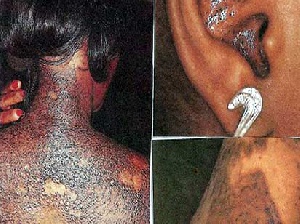Some years back, bleaching was practised mainly by women, but in recent times men have also joined the race. It has become the vogue among the youth.
It is not uncommon to see many Ghanaian women and some men who have lost their natural skin colour due to deformities such as burnt skin, wrinkles, skin blemishes and red spots on the skin bleaching.
Many African women bleach because of low self-esteem and cultural influence precipitated by colonial mentality of beauty as determined by some Europeans. Through their incessant racial abuse, these Europeans persuaded Africans to believe that their black skin is inferior.
Besides the fact that bleaching is an endorsement of mental slavery, most bleaching products and creams contain toxic chemical ingredients, including hydroquinone, glutathione and mercury. Hydroquinone prevents the skin from forming the substance responsible for skin color.
What is behind the color complex? In my opinion, variety is the spice of life, such as variety in foods and clothes as well as in nature. That is why people of different races have different types of skin.
Skin bleaching destroys the black pigments found in the top layer of the skin. When the dermis, that is, is the inner, thicker layer of the skin, cannot compensate for the absence of the epidermis, that is, is the outermost layer of the skin, coupled with the hot sun, the risk of getting cancer becomes higher.
The dermis includes various tissues, such as connective tissue, epithelial tissue, smooth muscle tissue, nervous tissue, and blood. The epidermis, on the other hand, is composed of keratinized stratified squamous epithelium.
Thus, to the question: to bleach or not to bleach? The ball is in your court to play. But I can tell you, reader, that being natural is beauty in itself.
Opinions of Sunday, 24 April 2016
Columnist: Latifa Carlos















